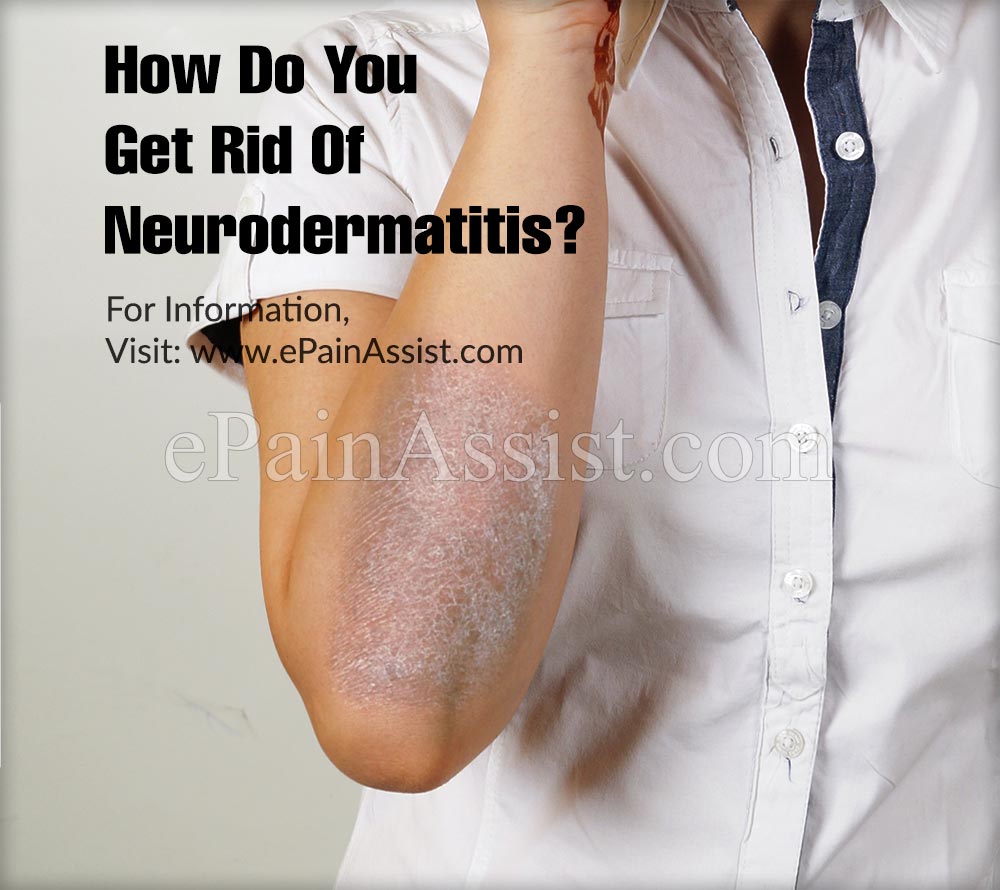How Do You Get Rid of Neurodermatitis?
Patients with neurodermatitis should be managed by clinicians who is expert as a mental health specialist and dermatologist, or management of both.

The three fundamental pillars of neurodermatitis treatment:
- Optimization of the patient’s mental state in terms of insight, motivation, and awareness.
- Pharmacologic therapies.
- Nonpharmacologic therapies.
Dermatologic Therapies — Complications of neurodermatitis including skin infection or disfigurement, may require medical, surgical, or cosmetic intervention. Topical and/or systemic antibiotics may be prescribed to treat secondarily infected excoriations or ulcerations.
Glucocorticoids such as triamcinolone acetonide are commonly used and appear to provide benefit, although there are no published studies of efficacy. Phototherapy with narrowband ultraviolet B has been reported as beneficial in reducing pruritus and skin picking behaviors in a small series of patients.
Antidepressants — when pharmacotherapy is selected for the treatment of neurodermatitis, we suggest initial treatment with selective serotonin reuptake inhibitor (SSRI) antidepressants, SSRIs have been shown to be efficacious in the treatment of obsessive-compulsive disorder. SSRIs should generally be started at their minimal effective dose: fluoxetine 20 mg, paroxetine 20 mg, citalopram 20 mg, escitalopram 10 mg, fluvoxamine 50 mg, and sertraline 50 mg. The dose can be increased every week or every other week, as tolerated. The clinical response to the SSRI antidepressants is gradual.
Common SSRI side effects include sexual dysfunction, drowsiness, weight gain, insomnia, anxiety, dizziness, headache, and dry mouth. When discontinuing an SSRI, a slow taper is advised, due to withdrawal symptoms such as nausea, diaphoresis, agitation, anxiety, dizziness, and sensory problems.
Antipsychotics — Antipsychotics may be helpful in selected patients with neurodermatitis particularly in delusional patients. The typical antipsychotic pimozide, a centrally acting dopamine receptor antagonist, has been widely used for the treatment of delusional infestation
Glutamate-modulating Drugs — N-acetylcysteine (an amino acid derivative that has glutamate-modulating properties) has been used alone or in combination with SSRI for the treatment of obsessive compulsive disorders in adults and children with promising results disorder in children and adolescents”,
The efficacy of N-acetylcysteine for the treatment of SPD (Skin Picking disorder) was subsequently evaluated in a randomized trial in which 66 participants with neurodermatitis received N-acetylcysteine at a dose of up to 3000 mg per day or placebo for 12 weeks. The main outcome measures were changes in the modified Yale-Brown Obsessive Compulsive Scale score and in the Clinical Global Impression severity scale score. At the end of the study, participants in the N-acetylcysteine group showed a significantly greater improvement in both scores compared with participants in the placebo group. The treatment was generally well tolerated. However, given the chronic nature of neurodermatitis, further studies are needed to evaluate the long-term efficacy and safety of N-acetylcysteine for the treatment of this disorder.
Anxiolytics — Anxiolytics may be used when the underlying cause of neurodermatitis is an anxiety disorder, although there are no specific studies of the use of anxiolytic drugs in the treatment of neurodermatitis.
Behavioral Treatments — Cognitive and behavioral therapies may be beneficial for patients accepting psychiatric referral. However, only a limited number of observational studies and randomized trials have examined non-pharmacologic therapeutic options for neurodermatitis, including cognitive-behavioral therapy, habit reversal therapy, and acceptance-enhanced behavior disorder in adults In a randomized trial, 34 college students were randomly assigned to treatment with a four-session course of cognitive-behavioral treatment or a waiting list control group Skin picking severity measures (skin picking scale, skin picking impact scale, and self-control cognition questionnaire) decreased significantly in the treatment group compared with the control group. Treatment effects were maintained at two months after the end of treatment.
The number of skin picking episodes decreased significantly over time in the treatment group, compared with the waiting list group. Benefits were maintained at three-month follow-up.
Clinical diagnosis is very important because there are many types of treatments for neurodermatitis; at the time of choosing one is the duty of the patient to be advised by a specialist. Choosing a treatment is not a joke, because it could have serious consequences.
Mayo Clinic. (2021). Neurodermatitis. https://www.mayoclinic.org/diseases-conditions/neurodermatitis/symptoms-causes/syc-20375634
- National Eczema Association. (n.d.). Neurodermatitis (lichen simplex chronicus). https://nationaleczema.org/eczema/types-of-eczema/neurodermatitis/
Also Read:
